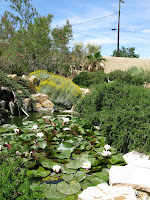full sun -- partial shade -- full shade
exposed -- sheltered -- indoors
moist -- regular water -- xeric
The following pictures show areas of my yard having various microclimates, and describe what is growing there.
 |
| Exposed, xeric, full sun |
This area is a fairly typical desert garden. Shown are a Chilean Mesquite tree, Golden Barrel Cacti, various Opuntia, a Blue Agave, a Turpentine Bush, a Red yucca, and in the background a Palo Verde, Mexican Fan Palm, Mediterranean Fan Palm, Dwarf Date Palm, Scotch Broom, a Texas Mountain Laurel, various other Yuccas. There are also Coyote Gourds and Jimson Weed that come up every year from seeds I throw around. All of these need some water, even after they have become established. The palms are on bubblers, the other plants on 1gph or 2gph emitters.
 |
| Exposed, xeric, full sun |
This area is designed to represent a desert oasis. Shown are Mexican Fan Palms, a Canary Island Palm, Olive trees, Pampas Grass, Lavender Cotton, Crape Myrtle, Desert Marigolds, Chocolate Flower, and in the background California Fan Palms and Eldarica Pines. There are also Pomegranate trees, Strawberry trees, and a Chaste tree in this area. All the plants are watered by bubblers, one system for the large plants, a second one for the shrubs.
 |
| Exposed, xeric, full sun |
This area is a screen which hides a gazebo from the house. Shown are a Palo Verde, Apache Plume, Rabbit Bush, Texas Ranger, Cotoneaster, Snowberry, newly planted Italian Cypress, Fountain Grass, Mexican Velvet Sage, and Gopher Plant. In the background are Fig trees and a Pistachio tree. The sprinkler system for the lawn in the foreground provides some water to the Snowberry, which is not really a xeric plant. Otherwise, everything is on the same system of bubblers. The steps lead to the gazebo.
 |
| Sheltered, xeric, partial shade |
This area under two pine trees is one of the few beds I water by hand. The trees have been there a long time and probably get their water from my septic tank. At least I don't water them. In this shady area close to the house I can grow aloes, bulbina, and some agaves that need a little protection from both sun and cold weather. Those blooming are Coral Aloes. The plants in the pots on the other side of the low wall also need shelter.
 |
| Sheltered, regular water, full sun |
This flower bed in on the east side of a wall which protects it from the wind. It is in the sun most of the day. Pictured are Indian Blanket, Verbena, and Allysum. Also in the bed are Iris, Gladiolas, Peonies, Hollyhocks, Osteospermum, Love-in-a-Mist, Bulbini Tulips, Poppies, and Daffodils. Flowers and vegetables needing regular water do best on the east side of walls where there is a little afternoon shade.
 |
| Sheltered, regular water, partial shade |
This flower bed is on the north side of the house, sheltered on the west by another part of the house. It is filled with Roses, Cannas, Hollyhocks, Shamrocks, Calendulas, Snapdragons, California Poppies, and of course weeds. The annuals migrated there on their own and reseed every year. Every Spring Daffodils and Bulbini Tulips provide the first color.
 |
| Sheltered, regular water, full shade |
This flower bed by the front door is in a north-east nook that does not receive any sun. Three types of Asparagus Fern grow there, also Coral Bells and Cyclamen. The volunteer Iris needs to be removed as it will not bloom if left in this location. There is also a Crinum Lily which needs the shelter, but does not bloom in the shade, and I am always trying other plants. Fibrous Begonia is marginal, but blooms, and also Purple Tradescantia.
 |
| Exposed, moist, full sun |
The only thing I have found that will survive in my fishpond is Hardy Water Lilies. Other plants either die or are eaten by the fish. The shrubs are Rosemary and Lavender Cotton. They are on the other side of the pond and have xeric watering. In the background, also xeric, are a Desert Willow and Mexican Fan Palms. My soil is sand which does not hold water well. So for me, any moisture-loving plants have to be such as actually grow in water.
 |
| Indoors, moist, partial sun |
My large hothouse contains a fish pond planted with Papyrus and Horsetails. Other pond plants I have tried have either died or been eaten by the fish. In the moist soil around the pond I have Anthurium, Peace Lilies, Ferns, and Bromeliads. This hothouse, with its misting system, turns out to be a great place to start seeds. Although I intended it as a place to garden in the winter and a place to grow tropical fruit, so far I am producing tomatoes all year long. It also is a place of quiet beauty, away from the railroad and freeway noise that I can't hide in the rest of the yard, despite fountains and a waterfall.
 |
| Indoors, xeric, partial sun |
My entry way is a great place for potted plants. There geraniums bloom all year long. Other than the geraniums, a Benjamin Ficus, and several Philodendrons, I have mostly Cacti and Succulents. The area has windows on three sides and the window ledge is fairly warm and sunny all year. This is also a plant nursery for plants that are too small to set out. And until I built the large hothouse, this was the place I started seeds in covered trays.